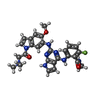Entry Database : PDB / ID : 3ekkTitle Insulin receptor kinase complexed with an inhibitor Insulin receptor Keywords / / / / / / / / / / / / / / / Function / homology Function Domain/homology Component
/ / / / / / / / / / / / / / / / / / / / / / / / / / / / / / / / / / / / / / / / / / / / / / / / / / / / / / / / / / / / / / / / / / / / / / / / / / / / / / / / / / / / / / / / / / / / / / / / / / / / / / / / / / / / / / / / / / / / / / / / / / / / / / / / / / / / Biological species Homo sapiens (human)Method / / Resolution : 2.1 Å Authors Chamberlain, S. / Atkins, C. / Deanda, F. / Dumble, M. / Gerding, R. / Groy, A. / Korenchuk, S. / Kumar, R. / Lei, H. / Mook, R. ...Chamberlain, S. / Atkins, C. / Deanda, F. / Dumble, M. / Gerding, R. / Groy, A. / Korenchuk, S. / Kumar, R. / Lei, H. / Mook, R. / Moorthy, G. / Redman, A. / Rowland, J. / Sabbatini, P. / Shewchuk, L. Journal : Bioorg.Med.Chem.Lett. / Year : 2009Title : Discovery of 4,6-bis-anilino-1H-pyrrolo[2,3-d]pyrimidines: Potent inhibitors of the IGF-1R receptor tyrosine kinase.Authors: Chamberlain, S.D. / Wilson, J.W. / Deanda, F. / Patnaik, S. / Redman, A.M. / Yang, B. / Shewchuk, L. / Sabbatini, P. / Leesnitzer, M.A. / Groy, A. / Atkins, C. / Gerding, R. / Hassell, A.M. ... Authors : Chamberlain, S.D. / Wilson, J.W. / Deanda, F. / Patnaik, S. / Redman, A.M. / Yang, B. / Shewchuk, L. / Sabbatini, P. / Leesnitzer, M.A. / Groy, A. / Atkins, C. / Gerding, R. / Hassell, A.M. / Lei, H. / Mook, R.A. / Moorthy, G. / Rowand, J.L. / Stevens, K.L. / Kumar, R. / Shotwell, J.B. History Deposition Sep 19, 2008 Deposition site / Processing site Revision 1.0 Dec 23, 2008 Provider / Type Revision 1.1 Jul 13, 2011 Group / Version format complianceRevision 1.2 Oct 20, 2021 Group / Derived calculations / Category / struct_ref_seq_dif / struct_siteItem _database_2.pdbx_DOI / _database_2.pdbx_database_accession ... _database_2.pdbx_DOI / _database_2.pdbx_database_accession / _struct_ref_seq_dif.details / _struct_site.pdbx_auth_asym_id / _struct_site.pdbx_auth_comp_id / _struct_site.pdbx_auth_seq_id Revision 1.3 Aug 30, 2023 Group / Refinement descriptionCategory / chem_comp_bond / pdbx_initial_refinement_model
Show all Show less
 Open data
Open data Basic information
Basic information Components
Components Keywords
Keywords Function and homology information
Function and homology information Homo sapiens (human)
Homo sapiens (human) X-RAY DIFFRACTION /
X-RAY DIFFRACTION /  MOLECULAR REPLACEMENT / Resolution: 2.1 Å
MOLECULAR REPLACEMENT / Resolution: 2.1 Å  Authors
Authors Citation
Citation Journal: Bioorg.Med.Chem.Lett. / Year: 2009
Journal: Bioorg.Med.Chem.Lett. / Year: 2009 Structure visualization
Structure visualization Molmil
Molmil Jmol/JSmol
Jmol/JSmol Downloads & links
Downloads & links Download
Download 3ekk.cif.gz
3ekk.cif.gz PDBx/mmCIF format
PDBx/mmCIF format pdb3ekk.ent.gz
pdb3ekk.ent.gz PDB format
PDB format 3ekk.json.gz
3ekk.json.gz PDBx/mmJSON format
PDBx/mmJSON format Other downloads
Other downloads 3ekk_validation.pdf.gz
3ekk_validation.pdf.gz wwPDB validaton report
wwPDB validaton report 3ekk_full_validation.pdf.gz
3ekk_full_validation.pdf.gz 3ekk_validation.xml.gz
3ekk_validation.xml.gz 3ekk_validation.cif.gz
3ekk_validation.cif.gz https://data.pdbj.org/pub/pdb/validation_reports/ek/3ekk
https://data.pdbj.org/pub/pdb/validation_reports/ek/3ekk ftp://data.pdbj.org/pub/pdb/validation_reports/ek/3ekk
ftp://data.pdbj.org/pub/pdb/validation_reports/ek/3ekk
 Links
Links Assembly
Assembly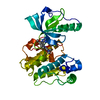
 Components
Components Homo sapiens (human) / Gene: INSR / Plasmid: pFastbac / Production host:
Homo sapiens (human) / Gene: INSR / Plasmid: pFastbac / Production host: 
 X-RAY DIFFRACTION / Number of used crystals: 1
X-RAY DIFFRACTION / Number of used crystals: 1  Sample preparation
Sample preparation ROTATING ANODE / Type: RIGAKU FR-E+ SUPERBRIGHT / Wavelength: 1.54 Å
ROTATING ANODE / Type: RIGAKU FR-E+ SUPERBRIGHT / Wavelength: 1.54 Å Processing
Processing MOLECULAR REPLACEMENT
MOLECULAR REPLACEMENT Movie
Movie Controller
Controller






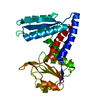
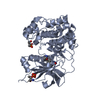

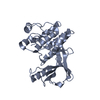
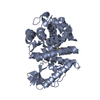


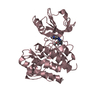
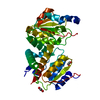
 PDBj
PDBj











